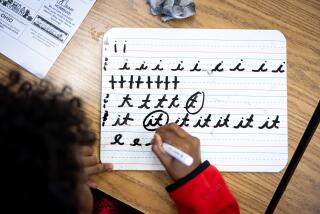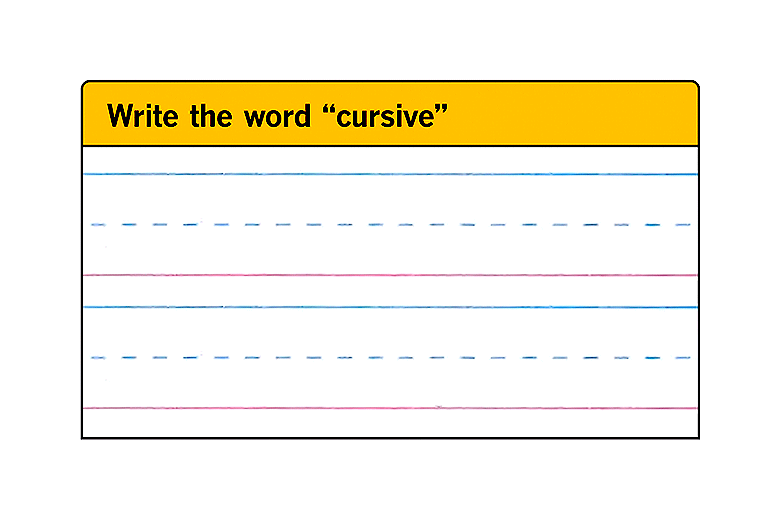Little PCs Read Writing, Raise Hopes, Hit Market
- Share via
For years scientists have theorized that personal computers ought to be able to recognize handwriting. And for almost as long, computer engineers have labored to create a machine that would operate in the time-honored tradition of ordinary pen and paper.
Now, after two decades in research labs, the first notebook-sized personal computers capable of recognizing handwriting are finally hitting the market in the United States and Japan. And with their customary zeal, PC enthusiasts are putting historians on notice.
“This stuff is real,” gushes Vern Rayburn, a personal-computer industry veteran and chairman of a new PC software company. “This will change how people do personal computing.”
But not right away.
Despite the hype and enthusiasm, the new devices are not what everyone expects of a handwriting-recognition computer. They read only neatly printed capital letters, not script or even upper- and lower-case printing. And their practical uses can be counted on one hand. Initially, for example, the machines will probably suit only mobile workers such as police officers, rental-car attendants, nurses and truckers, who fill in blanks on forms.
Nevertheless, these devices represent the latest step toward a goal that has long inspired PC engineers and enthusiasts: full-powered, carry-everywhere notebook computers, equipped for telecommunications and video, and capable of understanding speech and recognizing handwriting. These new computers use electronic pens, called styluses, that take the place of keyboards, and in this respect they are pioneers. Analysts and manufacturers foresee a day when such a stylus will be a common accessory for various computer operations done now with a mouse or a keyboard, including drafting, design, copy editing, training and education.
Before those days arrive, however, much work remains to be done on handwriting recognition. Still, even some of the most cautious analysts acknowledge that the continued miniaturization of computer components, the increasing power of PC microprocessors and the improved quality of computer screens have made early forms of the devices possible.
“The frontiers of technology have finally been pushed out far enough to allow these systems to come together,” says Richard Shaffer, who publishes a technology newsletter in New York. “But now the trick will be not to set consumer expectations too high. There’s a real danger in over-hype.”
But hyperbole seems almost unavoidable. The PC industry, which has been used to hoopla since its inception 13 years ago, has been searching in vain the last few years for a new “killer” product to boost sales and bring back some of the excitement of the early days. The early consensus is that these new devices may be just that product.
Some analysts are already forecasting a rosy future at the cash register.
Gray Glass, a technology analyst with Prudential-Bache Securities’ research unit in New York, estimates that the total potential market for these systems is a huge $12 billion annually. Peter Tiege, of InfoCorp, a Silicon Valley market research firm, estimates that as many as 6 million systems will be sold by 1995. And Tim Bajarin, executive vice president of Creative Strategies, a San Jose market research company, estimates that notebook computers equipped with electronic pens will account for 40% of total portable computer sales by 1993.
Speech recognition systems, generally considered as promising as their handwriting counterparts, haven’t come as far. To date, the only such systems available are sophisticated, expensive machines that recognize only a few words repeatedly used in specific applications. However, analysts say, promising research at Bell Laboratories could result in a telephone answering system that recognizes spoken numbers from one to nine.
Much of the current emphasis has been on handwriting recognition, and in the last nine months, three hand-held personal computers of limited capability have been introduced. Canon and Sony are selling models in Japan that read only Japanese characters, and Sony is said to be working on a version that can read Western languages. Grid Systems, a Silicon Valley-based division of Tandy Corp., started shipping its pad-and-pen style machine early this year.
At least one more U.S. company--Go Corp. in the Silicon Valley--is expected to launch a similar machine this year, while other computer makers, including International Business Machines, will license the Go technology for handwriting-recognition computers of their own. Development efforts have begun at several other companies, including Apple Computer in Cupertino and two new ventures, Momenta in Mountain View and SuperScript in Cambridge, Mass.
The swell of activity has spurred software publishers to start writing both specific and general purpose business programs that take advantage of the new technology. Without these programs, which still number fewer than a dozen, the devices are little more than a technology in search of a practical use.
In theory, these computers are almost as easy to use as a pencil and paper. The user simply writes with a metal stylus on a notebook-sized computer screen that can be held like a pad of paper or laid flat on a desk. The brains of the computer, housed in a flat panel under the screen, translate the handwritten characters into typewritten letters that appear on the screen.
The result is the same as if the material had been typed on a keyboard.
How does it work? Software in the computer senses how the letters are formed by tracking the sequence and position of the strokes. In some machines, the software determines what letter has been printed through a sophisticated mathematical formula.
In other systems, the software matches the pattern of the character written with the computer’s memory bank of possible characters, a process that can include a split-second side trip to a dictionary to resolve questionable sequences of letters. (The detour, however, won’t correct misspellings. It can only determine, for example, that a “V” doesn’t follow a “Q” in English words, and that the writer therefore probably wrote a “U.”)
Currently available versions of these machines have extremely limited applications, both because the technology isn’t sophisticated enough for more complex tasks, such as transcription of free-hand writing, and because there isn’t a wide variety of software yet.
The earliest applications center on what is known as “forms completion” by mobile workers who have traditionally not used computers on the job. In all these cases, the computer is replacing a clipboard of some sort. A grocery truck driver records a delivery and enters a re-order; an insurance-claims adjuster evaluates property damage and calculates coverage; or a police officer completes an accident report or issues a ticket.
Software publishers have promised to deliver programs with more general business applications--such as the ability to work with spreadsheets, calendars and memos--within the next 12 months. In the more distant future are programs for architecture, education, and design applications.
Until then, worries abound that the lure of the technology will lead its promoters to promise more than it can immediately deliver, thus souring thousands of consumers.
“If we don’t do it right,” warns Alan Lefkof, president of Grid Systems, “all of our efforts could turn out to be nothing more than an expensive Etch-a-Sketch.”
LIKE PENCIL AND PAPER . . . ALMOST
How could you really use a notepad computer? Technology analyst and respected personal computer pundit Richard Shaffer offers these ideas:
Executive letter writing. An executive jots down some thoughts and sends them to the staff for rewriting into a full document. Later, the executive can review the letter and make handwritten changes in the margins of the computer screen.
Chart minding. Nurses and other medical personnel update patients’ charts that are kept in electronic notebooks.
Note keeping. You can’t type on your portable PC during a staff meeting, but note taking in the familiar yellow pad is not only acceptable, but a sign of interest. So why not write notes into your computer, and save the later effort of transcribing? Electronic doodling--it’s a bit like an Etch-a-Sketch--can pass away the duller moments.
Handwriting instruction. It would be a fun and easy way to teach penmanship in the schools, especially if linked with sound. This is an early educational use of the technology, but there will be lots more.
Refrigerator door substitute. The ultimate gadget for what Shaffer calls the “designer houseware set.” The system would hold notes for the babysitter, grocery lists, telephone numbers and art work of early childhood.






